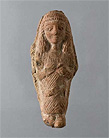Religion
In today’s world, religion can be among the strongest aspects of identity: Jews, Christians, Muslims, Hindus, and Buddhists, among many others, are groups recognized by members and outsiders.
In most of ancient Middle Eastern history, religion was polytheistic—people worshipped many deities. It was appropriate for worshippers to approach different gods for help with different problems, so common people and kings would have had regular relationships with a wide range of deities. Thus, worship of a single god did not provide a basis for group identity in the ancient Middle East.
At the broadest level, there were obvious differences in religious practices and beliefs across the ancient Middle East. Thus, Egyptian religion differs in some ways from Nubian religion, and both differed from Hittite or Mesopotamian religion. Different gods were worshipped in each area, in different kinds of temples, and with different rituals. So at this broad level, religion could be a basis for identity.
At the same time, some deities and some religious practices were shared across broad areas that otherwise were not unified by ethnicity. For example, the Sumerian goddess Inanna was merged with the early Semitic goddess Ishtar, and Ishtar was eventually worshipped as Astarte in Canaanite culture along the Mediterranean coast. The early Semitic storm-god Adad was also the Amorite storm-god Addu and the Hittite storm-god Hadad. Although there were local differences among these various deities, the merging of their identities meant that religious practices were more similar across broad areas than might be assumed.

 Geoff Emberling
Geoff Emberling
Former Chief Curator, Oriental Institute Museum of the University of Chicago
Guiding Questions
1. What kinds of things relate to or contribute to a person’s sense of identity? How is an understanding of identities crucial to the study of history?
2. What were some of the various ways that people in the ancient Middle East identified themselves?
3. Why is our tendency today to use religious affiliation as a main part of one’s identity a misleading approach when looking at the ancient Middle East?


 Print Page
Print Page

